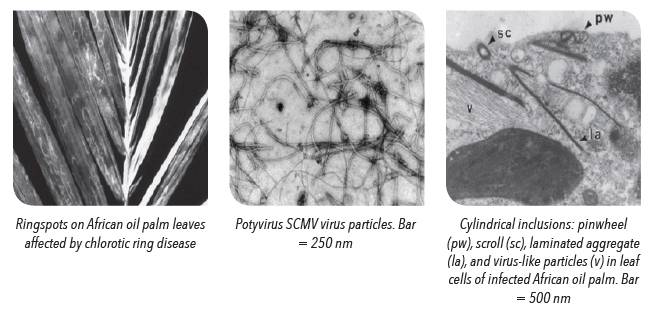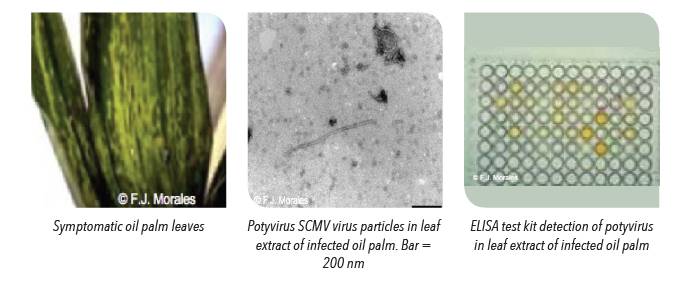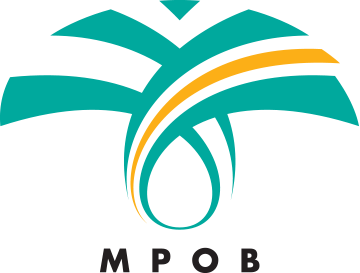General information

SCMV is a seed-borne virus. The virus is a strain of the sugarcane mosaic virus (SCMV). Infected oil palm (Elaeis guineensis Jacq.) seedlings exhibit mottling, chlorotic streaks – alternating dark green and chlorotic areas in discontinuous streaks, and ringspots.
Distribution
South America, India** ** Diseased oil palm seedlings in nurseries in Karnataka State, India, were of planting materials imported from Costa Rica.
Detection and Inspection
Symptoms are indicative of the viral infection. Definitive detection and identification of the virus can only be achieved through microscopy and molecular diagnostic tools. The leaf sap can be examined using electron microscopy.
The leaf extract should be negatively stained in 2% uranyl acetate, pH 3.7 before observation. If present, flexous filamentous particles of approx. 750 nm long can be observed.
Cytophathological examination can also be employed to detect presence of the virus. Ultra-thin sections of symptomatic leaves will reveal cytoplasmic inclusions (e.g. pinwheels, laminated aggregates and scrolls) in mesophyll tissues, characteristic of potyviruses.
Molecular diagnostic tool using RT-PCR to detect SCMV uses Oligo 5’-d(T)18(AGC)-3’ as the reverse and 5’- ATGTC(GA) AAGAA(GA)ATGCGCTTGC-3’ as the forward primer. The amplicons for SCMV are composed of 900 bp fragments from the 3’ termini.
Prevention and Control
PHYTOSANITARY SCMV
can be transmitted by seed (potentially also through tissue culture). The import of germplasm material (seeds, pollen, tissue culture) must be accompanied by an import permit issued by or on behalf of the Director-General Department of Agriculture for Peninsular Malaysia (including Labuan), or the Director Department of Agriculture for Sabah, and a phytosanitary certificate issued by an authorised official from the country of export. The import conditions are available upon request from the Plant Biosecurity Division Malaysia. All consignments are subjected to inspection by the Department of Agriculture prior to clearance by Customs. Germplasm material imported from high risk areas should be sent for third country quarantine before arrival onto Malaysian shores. The import of alternative hosts i.e. Saccharum officinarum, Zea mays, Sorghum bicolor from infested areas should be enquired with DOA.
CULTURAL CONTROL AND SANITARY METHODS
There are currently no effective treatments of chlorotic ring diseases, and the best method for infection control is the removal and destruction of hosts/plant material.

Further reading
- Corley, R H V and Tinker, P B H (2003). The Oil Palm (4th ed.). Blackwell Science Ltd: USA. 592 pp.
- Morales, F J; Lozano, I; Sedano, R; Castano, M and Arroyave, J (2002). Partial Characterization of a Potyvirus Infecting African Oil Palm in South America. J. Phytopathology, 150: 297-301.
- Morales, F J; Lozano, I; Castano, M; Arroyave, J; Pene, E; Olaya, C and Martinez, A K (2009). Poster: Detection and diagnosis of viruses infecting African and American oil palms (Elaeis guineensis and E. oleifera). CIAT. URL: www.slideshare.net/CIAT/poster81. FACTSHEET
- Reddy, C V; Sreenivasulu, P and Sekhar, G (2011). Duplex-immunocapture-RT-PCR for detection and discrimination of two distinct potyviruses naturally infecting sugarcane (Saccharum spp. hybrid). Indian J. Exp. Biol. 49(10): 68-73.
- Rivera, C; Pereira, R; Moreira, L and Chinchilla, C (1996). Detection of Potyvirus-like Particles Associated with Oil Palms (Elaeis guineensis) in Ecuador. Plant Dis. 80: 1301. DOI: 10.1094/PD-80-1301D.
- Singh, D and Mathur, S B (1932). Histopathology of seed-borne infections. CRC Press: USA. 296 pp.
- Solomon, J J and Babu, M K (1998). Incidence of potyvirus disease in oil palm nursery seedlings. J. Oil Palm Res., 10(1): 52-56.

